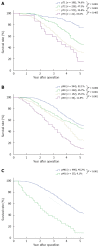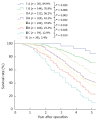Evaluation of the 7th edition of the TNM classification in patients with resected esophageal squamous cell carcinoma
- PMID: 25561808
- PMCID: PMC4277978
- DOI: 10.3748/wjg.v20.i48.18397
Evaluation of the 7th edition of the TNM classification in patients with resected esophageal squamous cell carcinoma
Abstract
Aim: To evaluate the prognostic factors and tumor stages of the 7(th) edition TNM classification for esophageal cancer.
Methods: In total, 1033 patients with esophageal squamous cell carcinoma (ESCC) who underwent surgical resection with or without (neo)adjuvant therapy between January 2003 and June 2012 at the Thoracic Surgery Department II of the Beijing Cancer Hospital, Beijing, China were included in this study. The following eligibility criteria were applied: (1) squamous cell carcinoma of the esophagus or gastroesophageal junction identified by histopathological examination; (2) treatment with esophagectomy plus lymphadenectomy with curative intent; and (3) complete pathologic reports and follow-up data. Patients who underwent non-curative (R1) resection and patients who died in hospital were excluded. Patients who received (neo)adjuvant therapy were also included in this analysis. All patients were restaged using the 7(th) edition of the Union for International Cancer Control and the American Joint Committee on Cancer TNM staging systems. Univariate and multivariate analyses were performed to identify the prognostic factors for survival. Survival curves were plotted using the Kaplan-Meier method, and the log-rank test was used to evaluate differences between the subgroups.
Results: Of the 1033 patients, 273 patients received (neo)adjuvant therapy, and 760 patients were treated with surgery alone. The median follow-up time was 51.6 mo (range: 5-112 mo) and the overall 5-year survival rate was 36.4%. Gender, "pT" and "pN" descriptors, (neo)adjuvant therapy, and the 7(th) edition TNM stage grouping were independent prognostic factors in the univariate and multivariate analyses. However, neither histologic grade nor cancer location were independent prognostic factors in the univariate and multivariate analyses. The 5-year stage-based survival rates were as follows: IA, 84.9%; IB, 70.9%; IIA, 56.2%; IIB, 43.3%; IIIA, 37.9%; IIIB, 23.3%; IIIC,12.9% and IV, 3.4%. There were significant differences between each adjacent staging classification. Moreover, there were significant differences between each adjacent pN and pM subgroup. According to the pT descriptor, there were significant differences between each adjacent subgroup except between pT3 and pT4 (P = 0.405). However, there was no significant difference between each adjacent histologic grade subgroup and between each adjacent cancer location subgroup.
Conclusion: The 7(th) edition is considered to be valid for patients with resected ESCC. However, the histologic grade and cancer location were not prognostic factors for ESCC.
Keywords: Esophageal squamous cell carcinoma; Prognosis; Staging; Surgery; Survival; TNM.
Figures



Similar articles
-
Prognostic factors and outcome for patients with esophageal squamous cell carcinoma underwent surgical resection alone: evaluation of the seventh edition of the American Joint Committee on Cancer staging system for esophageal squamous cell carcinoma.J Thorac Oncol. 2013 Apr;8(4):495-501. doi: 10.1097/JTO.0b013e3182829e2c. J Thorac Oncol. 2013. PMID: 23446203 Clinical Trial.
-
Lymph node ratio-based staging system for esophageal squamous cell carcinoma.World J Gastroenterol. 2015 Jun 28;21(24):7514-21. doi: 10.3748/wjg.v21.i24.7514. World J Gastroenterol. 2015. PMID: 26139998 Free PMC article.
-
Comparison of the 7th and proposed 8th editions of the AJCC/UICC TNM staging system for esophageal squamous cell carcinoma underwent radical surgery.Eur J Surg Oncol. 2017 Oct;43(10):1949-1955. doi: 10.1016/j.ejso.2017.06.005. Epub 2017 Jun 23. Eur J Surg Oncol. 2017. PMID: 28716377
-
Recommendations for pathologic staging (pTNM) of cancer of the esophagus and esophagogastric junction for the 8th edition AJCC/UICC staging manuals.Dis Esophagus. 2016 Nov;29(8):897-905. doi: 10.1111/dote.12533. Dis Esophagus. 2016. PMID: 27905172 Free PMC article.
-
Recommendations for neoadjuvant pathologic staging (ypTNM) of cancer of the esophagus and esophagogastric junction for the 8th edition AJCC/UICC staging manuals.Dis Esophagus. 2016 Nov;29(8):906-912. doi: 10.1111/dote.12538. Dis Esophagus. 2016. PMID: 27905170 Free PMC article.
Cited by
-
The Prognostic Impact of Lymph Node Involvement in Large Scale Operable Node-Positive Esophageal Squamous Cell Carcinoma Patients: A 10-Year Experience.PLoS One. 2015 Jul 15;10(7):e0133076. doi: 10.1371/journal.pone.0133076. eCollection 2015. PLoS One. 2015. PMID: 26177369 Free PMC article.
-
Four transcription profile-based models identify novel prognostic signatures in oesophageal cancer.J Cell Mol Med. 2020 Jan;24(1):711-721. doi: 10.1111/jcmm.14779. Epub 2019 Nov 19. J Cell Mol Med. 2020. PMID: 31746108 Free PMC article.
-
Post-neoadjuvant cellular dissociation grading based on tumour budding and cell nest size is associated with therapy response and survival in oesophageal squamous cell carcinoma.Br J Cancer. 2019 Dec;121(12):1050-1057. doi: 10.1038/s41416-019-0623-2. Epub 2019 Nov 6. Br J Cancer. 2019. PMID: 31690830 Free PMC article.
-
Prognostic nomogram for previously untreated patients with esophageal squamous cell carcinoma after esophagectomy followed by adjuvant chemotherapy.Jpn J Clin Oncol. 2016 Apr;46(4):336-43. doi: 10.1093/jjco/hyv206. Epub 2016 Jan 26. Jpn J Clin Oncol. 2016. PMID: 26819278 Free PMC article.
-
Integrin-linked kinase affects the sensitivity of esophageal squamous cell carcinoma cells to chemotherapy with cisplatin via the Wnt/beta-catenin signaling pathway.Bioengineered. 2022 May;13(5):12532-12547. doi: 10.1080/21655979.2022.2076497. Bioengineered. 2022. PMID: 35587162 Free PMC article.
References
-
- Edge SB, Byrd DR, Compton CC, Fritz AG, Greene FL, TrottiA . American Joint Committee on Cancer (AJCC) cancerstaging manual. 7th ed. Chicago: Springer; 2010.
-
- Rusch VW, Rice TW, Crowley J, Blackstone EH, Rami-Porta R, Goldstraw P. The seventh edition of the American Joint Committee on Cancer/International Union Against Cancer Staging Manuals: the new era of data-driven revisions. J Thorac Cardiovasc Surg. 2010;139:819–821. - PubMed
-
- Rice TW, Rusch VW, Apperson-Hansen C, Allen MS, Chen LQ, Hunter JG, Kesler KA, Law S, Lerut TE, Reed CE, et al. Worldwide esophageal cancer collaboration. Dis Esophagus. 2009;22:1–8. - PubMed
-
- Lin CS, Chang SC, Wei YH, Chou TY, Wu YC, Lin HC, Wang LS, Hsu WH. Prognostic variables in thoracic esophageal squamous cell carcinoma. Ann Thorac Surg. 2009;87:1056–1065. - PubMed
-
- Rice TW, Blackstone EH, Rybicki LA, Adelstein DJ, Murthy SC, DeCamp MM, Goldblum JR. Refining esophageal cancer staging. J Thorac Cardiovasc Surg. 2003;125:1103–1113. - PubMed
Publication types
MeSH terms
LinkOut - more resources
Full Text Sources
Other Literature Sources
Medical

